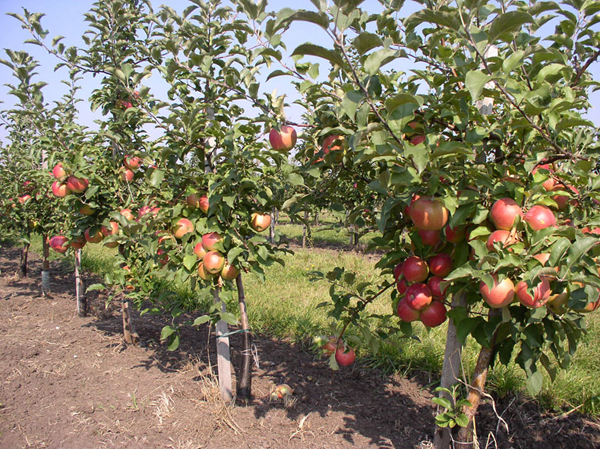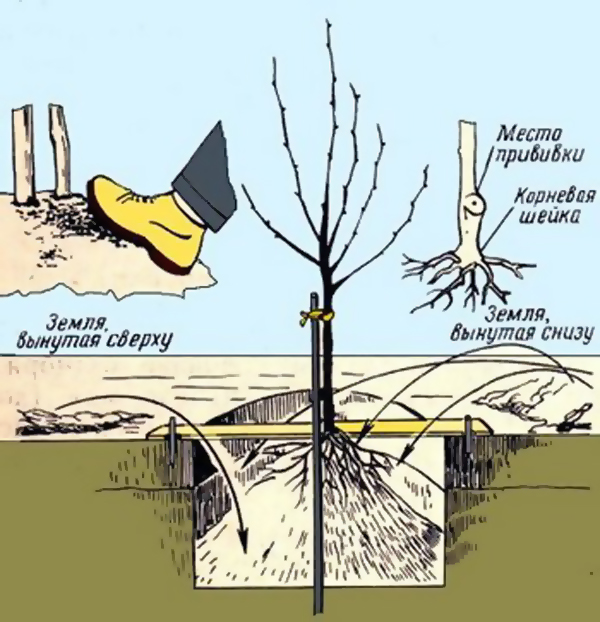Features of planting dwarf apple trees
Recently, many gardeners are interested in dwarf apple trees, which are grafted onto dwarf rootstocks. After reading this article, you will find answers to questions regarding the advantages of low-growing apple trees, you will learn how to acquire and properly plant a seedling of such a tree in your summer cottage.
Content
Benefits of dwarf apple trees
Due to the fact that dwarf apple trees have considerable advantages and advantages in comparison with vigorous ones, their popularity in the world is growing at a tremendous pace. Why are gardeners so attracted to undersized varieties?
Early fruiting
Begin to bear fruit early. This is a very important factor for gardeners, as fruit trees are planted in order to obtain a rich and generous harvest. So, for comparison, vigorous varieties begin to bear fruit only 5 years after planting, they will need at least another 10 years to increase the yield. And you will be able to get a constant harvest only after 17 years, when the period of active fruiting is reached. While with undersized varieties, the situation looks different. Already 3 years after planting, it will delight you with the first fruiting. Already after 8 years, you can harvest a permanent full harvest of apples. Simple arithmetic shows that "dwarfs" begin to give a constant harvest 10 years earlier than usual. Agree, which of the summer residents will refuse such a copy on their site.
Easy to clean
Proceeding from the fact that the height of a bonsai does not exceed 2.5 meters, all the measures for caring for it are very easy and simple to carry out. Harvest, prune and spray with ease. At that time (for comparison) an ordinary fruit tree was up to 9 meters high. With such a height, the crown will be at least 8 m.With such growth rates, only a small part of the crown remains at an accessible level for a person. Accordingly, harvesting, and simply carrying out all the necessary agrotechnical measures, becomes quite problematic. In this regard, it is necessary to resort to the help of special tools and equipment.
Compactness
For example, the nutritional area of an ordinary fruit tree is 40 to 48 square meters or even more. While the food area of the "younger brother" does not exceed 9 meters. Hence the conclusion and another advantage: up to 6 dwarf trees can be planted in the area of one ordinary fruit tree.

Features of the root system
The roots of low-growing varieties are very highly branched and most of them are located in the upper layers of the earth. Due to this feature, such gardens can be excellently grown in areas with a surface location of groundwater. While strong-growing apple trees take root hard in such conditions, they often get sick and often die.
High yield
Low-growing trees are much more productive than conventional trees. This fact has been repeatedly proven and confirmed by agronomists and professional gardeners. At the same time, the fruits are of excellent quality.
Based on the above advantages, it is possible to draw solid conclusions that explain the popularity of these varieties with gardeners around the world.
How to choose an apple tree seedling
In order to acquire just a stunted apple tree, and not be deceived and buy ordinary game instead of it, the grafted seedling should be known and distinguished from the unvaccinated one (wild).If it is grafted, then in the place where the root passes into the trunk (root collar) and between the stem, you will notice a distinct knee-shaped protrusion. And a fused cut above the already grafted kidney will be visible.
As a rule, a grafted two-year-old "dwarf" has a bole up to 50 cm in height and 4–7 developed branches. The branches should have large buds at the ends. While in the wild there will be a lot of twigs and they are all pointed, without buds.
Examine the root system carefully. The roots are composed of small roots, they are elastic, without damage. In the wild, the root system is represented by one main taproot. Do not forget about the top of the tree: the branches should not be injured, and the bark should be dry.
The variety you choose will depend on the location of the groundwater in your garden. In the event that the groundwater runs deep, below 3 meters from the surface, you can choose a plant on any of the rootstocks: dwarf, semi-dwarf or vigorous.
If, on your site, groundwater is located no deeper than 2.5 meters from the surface of the earth, then a strong-growing variety will no longer suit you. Its roots will be oversaturated with moisture, as a result - frequent diseases, poor harvests, low winter hardiness. For such summer cottages, varieties on a semi-dwarf rootstock would be the best option.
In an area where groundwater is located at the very surface, at a depth of up to 1.5 meters, strictly dwarf rootstocks can be grown. They have a highly developed superficial root system; they do not exceed 2.5 meters in height.
If, when buying a seedling, you want to be convinced of the professionalism of the seller, ask him the question: what kind of stock is the variety you have chosen. If you do not receive an intelligible answer, it means that you are in front of a fraudster trying to sell you some kind of wild game instead of an undersized variety. You shouldn't buy anything from such a seller. Of course, you need to buy seedlings from horticultural farms and nurseries. Specialists of such organizations will always offer the best option for your site and give valuable advice on care.
After you have purchased a stunted seedling, its root system should be carefully wrapped in a wet rag and placed in a plastic bag. During transportation, make sure that the branches are not damaged. To do this, it is recommended to fasten them to the trunk with twine. It is advisable to plant the purchased seedling immediately after purchase. If this is not possible, the tree should be buried in moist soil so that the roots do not dry out.
Planting technology for dwarf seedlings
Planting low-growing varieties is similar to planting a regular apple tree, but there are some differences. Remember to keep the soil as fertile as possible. If the soil leaves much to be desired, then you will have to dig a large hole up to 1.5 meters deep and up to 1 meter wide, which should be filled with fertile soil. Groundwater should be located close to the ground, since the root system of adult dwarf trees goes 1 meter deep, no more.
It is better to plant in calm weather; both elevated areas and slopes are suitable for planting. It is good when the landing site will be illuminated by the sun, but if this is not possible, there is nothing wrong with that, it is permissible.
Before planting, inspect the roots of the seedling, in what condition they are. If the root system has time to dry out, then it is advisable to place the roots in water for a day or at least overnight.
If the soil has been dug deep beforehand, then there is no need to prepare a hole for planting in advance. Dig a hole 50 cm deep and up to 70 cm in diameter. Set the top layer of the earth (the most fertile) aside - you will need it later. Pour a bucket of humus at the bottom of the prepared pit, add the deposited earth and fill it all with several buckets of water. Carefully place the seedling in this viscous slurry, but so that the grafting site is not covered with earth, but is located 2-3 centimeters above the edge of the pit.Then sprinkle the seedling with the remaining soil, compact and form a near-stem roller. Its height is 10 centimeters, and its diameter should not exceed 65 centimeters. It is advisable to mulch the trunk circle with humus.

Apple tree planting scheme
If you plant several low-growing apple trees at once, remember that you need to adhere to a certain distance between them. It is advisable to plant trees at least 2 meters apart.
The planted seedlings should be regularly looked after during the summer. First of all, you need to establish proper watering. It is recommended to pour 2 buckets of water under each weekly. Don't forget about feeding. It is recommended to carry it out with mullein infusion in a ratio of 1:10 or chicken droppings (1:20).
Be sure to loosen the soil around the young tree after each watering or immediately after rain.
After reading this article, you can independently lay a garden of dwarf apple trees. After all, now you know all the subtleties of this process. And in a few years the garden will thank you for your efforts and care with a generous harvest of bulk apples.
Video "Planting dwarf apple trees"
This video will show you how to properly plant dwarf apple trees.
